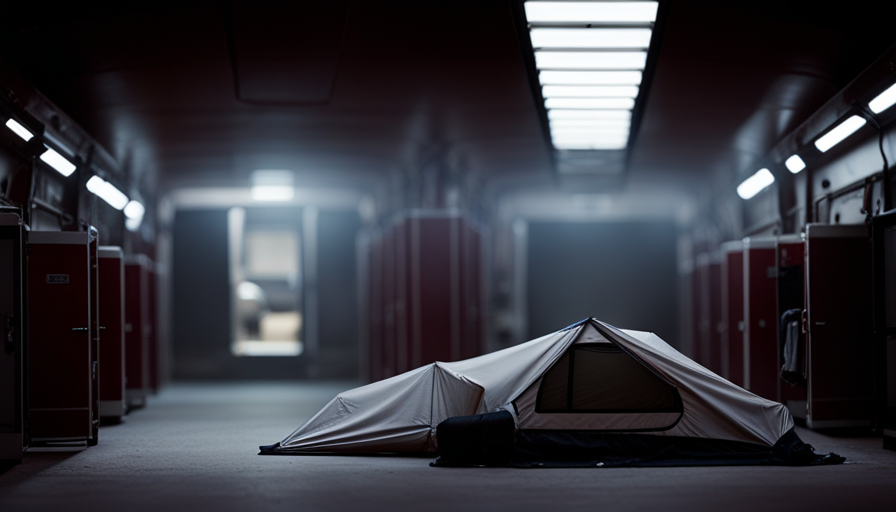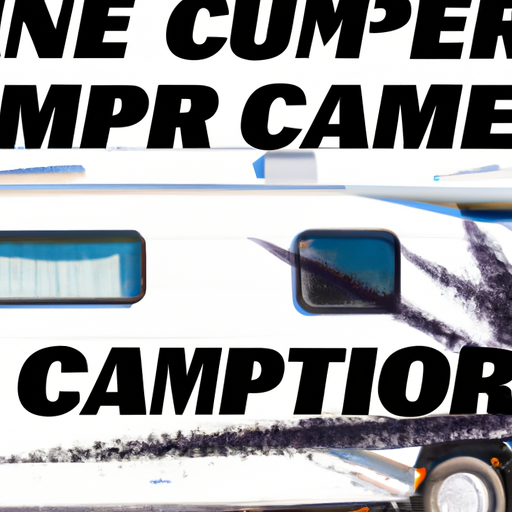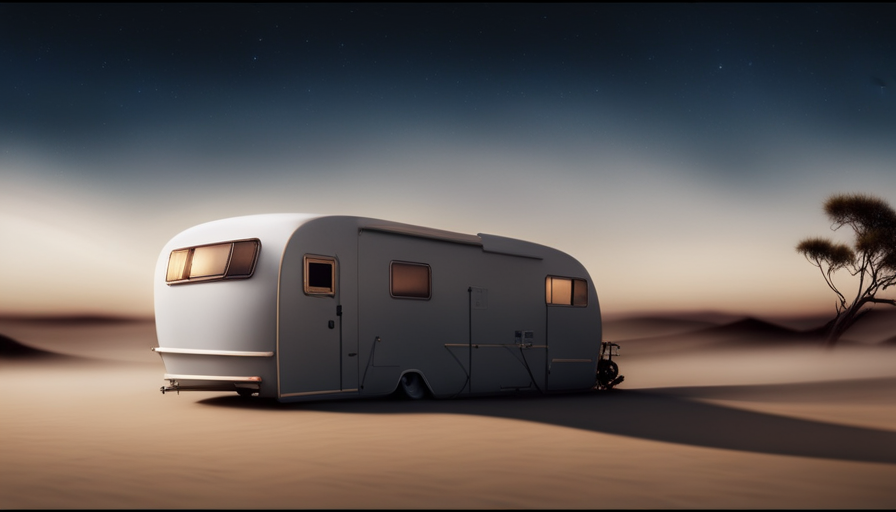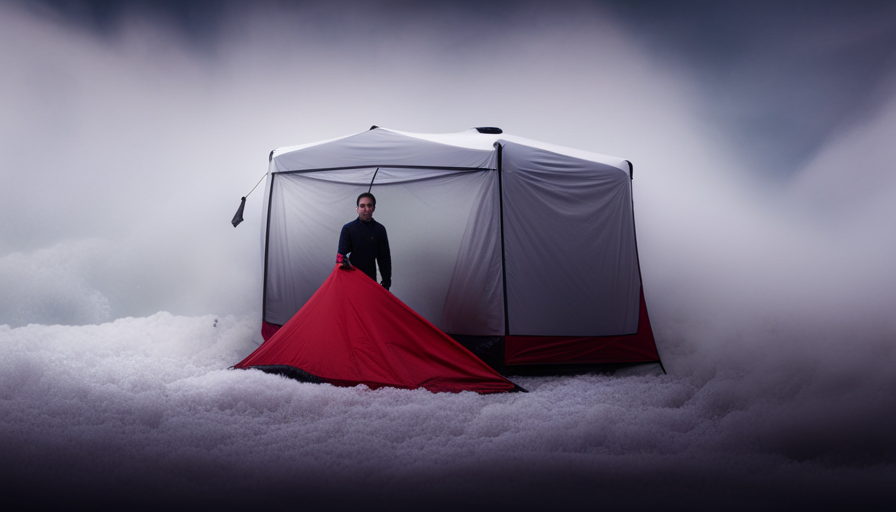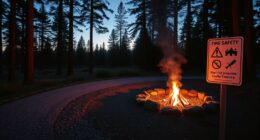Were you aware that carbon monoxide (CO), often referred to as the “invisible killer,” is responsible for the deaths of hundreds of individuals annually? The Centers for Disease Control and Prevention reports that on average, 430 people in the United States succumb to accidental carbon monoxide poisoning every year.
This odorless, colorless gas can be particularly dangerous in campers, where confined spaces and potential sources of CO can create a deadly combination. In this article, we will explore the common sources of carbon monoxide in campers and discuss the importance of proper ventilation to prevent CO buildup.
We will also learn how to recognize the symptoms of carbon monoxide poisoning and discuss preventative measures to ensure your safety. Additionally, we will delve into safe practices for using portable generators, educate ourselves on carbon monoxide safety, and touch on emergency preparedness.
By following these guidelines and seeking professional help when necessary, we can enjoy our camping adventures while keeping ourselves and our loved ones safe from the dangers of carbon monoxide.
Key Takeaways
- Improper use of portable gas-powered appliances in campers is a common source of carbon monoxide.
- Blocked vents can hinder proper airflow and should be cleared to prevent carbon monoxide buildup.
- Carbon monoxide can quickly infiltrate enclosed spaces like campers, making proper ventilation essential.
- Regular inspections and maintenance of gas appliances in campers are necessary to prevent carbon monoxide buildup.
Common Sources of Carbon Monoxide in Campers
One of the most common sources of carbon monoxide in campers is the improper use of portable gas-powered appliances, such as generators or stoves. These appliances can emit carbon monoxide if they’re not properly maintained or if they’re used in enclosed spaces without proper ventilation. Carbon monoxide is a colorless, odorless gas that can be deadly if inhaled in high concentrations.
To prevent carbon monoxide buildup in a camper, it’s crucial to have carbon monoxide detectors installed. These detectors can alert you if there’s a potential carbon monoxide leak, allowing you to take immediate action to protect yourself and others. It’s important to regularly test and replace the batteries in these detectors to ensure their effectiveness.
In addition to portable gas-powered appliances, other potential sources of carbon monoxide leaks in campers include malfunctioning propane heaters, leaking exhaust systems, and blocked vents. Regular maintenance and inspections of these systems are necessary to identify and fix any issues before they become a safety hazard.
Proper ventilation is essential in preventing carbon monoxide buildup in a camper. Opening windows and vents can help circulate fresh air and remove any carbon monoxide that may be present. It’s important to ensure that vents aren’t blocked by snow, ice, or debris to maintain proper airflow.
By being aware of the potential sources of carbon monoxide and taking the necessary precautions, you can ensure the safety of yourself and your fellow campers. Proper ventilation is key to preventing carbon monoxide buildup and should always be prioritized.
Importance of Proper Ventilation
Proper ventilation is essential in a camper to prevent the buildup of harmful gases like carbon monoxide. When camping, it’s important to prioritize emergency preparedness and adhere to camping etiquette to ensure the safety of all campers. Carbon monoxide is a colorless and odorless gas that can be produced by various sources in a camper, such as a faulty propane stove, generator, or heater. Without proper ventilation, these appliances can release carbon monoxide into the living space, putting campers at risk of carbon monoxide poisoning.
To maintain a safe environment inside the camper, it’s crucial to have adequate ventilation. This can be achieved by opening windows and vents, allowing fresh air to circulate and reducing the concentration of carbon monoxide. Additionally, it’s important to regularly inspect and maintain all appliances that emit carbon monoxide, ensuring they’re in good working condition.
By practicing these safety measures, campers can minimize the risk of carbon monoxide buildup and poisoning.
Recognizing the symptoms of carbon monoxide poisoning is crucial for early detection and treatment. However, prevention is always better than cure. In the next section, we’ll discuss the importance of recognizing the symptoms of carbon monoxide poisoning to ensure prompt action and safety.
Recognizing the Symptoms of Carbon Monoxide Poisoning
When it comes to recognizing the symptoms of carbon monoxide poisoning, it’s important to be aware of the key indicators. These include headaches, dizziness, and nausea, which can often be mistaken for common ailments.
Additionally, confusion and disorientation are also common symptoms, which can make it difficult to identify the cause of the discomfort.
Lastly, difficulty breathing and loss of consciousness are severe signs that immediate action should be taken to ensure safety.
Headaches, dizziness, and nausea
Experiencing headaches, dizziness, and nausea can be signs of carbon monoxide in a camper. These symptoms occur because carbon monoxide is a colorless and odorless gas that can easily go unnoticed. When inhaled, it binds to hemoglobin in our blood, preventing it from carrying oxygen to vital organs. This oxygen deprivation can lead to headaches, dizziness, and nausea.
Headaches may range from mild to severe, and they may worsen with prolonged exposure. Dizziness can manifest as a feeling of lightheadedness or unsteadiness, making it difficult to maintain balance. Nausea may accompany these symptoms, causing a general feeling of discomfort and unease.
It is crucial to recognize these signs and take immediate action to prevent carbon monoxide poisoning. Furthermore, confusion and disorientation can also occur, which we will discuss in the subsequent section.
Confusion and disorientation
Feeling confused and disoriented? It’s important to recognize these symptoms as they could be a sign of a serious problem.
Confusion and disorientation are common symptoms of carbon monoxide poisoning in a camper. The lack of oxygen caused by high levels of carbon monoxide in the air can affect the brain, leading to cognitive difficulties.
Confusion prevention starts with proper ventilation and regular maintenance of the camper’s heating system. Blocked exhaust vents or faulty appliances can cause carbon monoxide to accumulate inside the camper, leading to disorientation. It’s crucial to install and regularly test carbon monoxide detectors in the camper to ensure early detection of any leaks.
If you’re experiencing confusion or disorientation, it’s vital to take immediate action, as these symptoms can escalate to difficulty breathing and loss of consciousness, which we’ll discuss next.
Difficulty breathing and loss of consciousness
After experiencing confusion and disorientation due to carbon monoxide in our camper, we soon found ourselves facing an even more alarming symptom: difficulty breathing and loss of consciousness.
Carbon monoxide, a silent but deadly gas, can quickly infiltrate enclosed spaces like campers, leading to severe health risks. When inhaled, it binds to hemoglobin, reducing the amount of oxygen that our bodies can transport. This lack of oxygen can cause shortness of breath, chest pain, and eventually loss of consciousness.
It is crucial to recognize these symptoms and take immediate action to prevent further harm. Ventilation is key in ensuring fresh air circulation, as well as installing carbon monoxide detectors in the camper. By prioritizing safety measures and being aware of the risks, we can better protect ourselves from the dangers of carbon monoxide buildup.
Preventative Measures for Carbon Monoxide Buildup
To avoid being gassed like a Thanksgiving turkey, campers should ensure proper ventilation and regularly inspect their gas appliances for any potential carbon monoxide buildup. When it comes to emergency preparedness and camping etiquette, preventing carbon monoxide buildup should be a top priority.
Firstly, campers should ensure that their camper or tent has proper ventilation. This means keeping windows and vents open to allow fresh air to circulate and prevent the accumulation of carbon monoxide.
Additionally, campers should regularly inspect their gas appliances, such as stoves, heaters, and refrigerators, to ensure that they’re in good working condition and not producing excessive amounts of carbon monoxide.
It’s also important to never use gas appliances inside the camper or tent, as this can lead to a dangerous buildup of carbon monoxide. Instead, use them outside in a well-ventilated area.
Furthermore, campers should consider investing in carbon monoxide detectors for added safety. These detectors can alert you to the presence of carbon monoxide before it becomes a serious threat.
In conclusion, by following these preventative measures, campers can ensure their safety and avoid the dangers of carbon monoxide buildup. Moving on to safe practices for using portable generators…
Safe Practices for Using Portable Generators
When it comes to using portable generators, there are a few key safety practices that we need to keep in mind.
First and foremost, it’s crucial to keep the generator at least 20 feet away from the camper to prevent carbon monoxide buildup.
Secondly, running a generator inside the camper or near open windows should never be done, as it can lead to the deadly gas seeping into the living area.
Lastly, ensuring proper ventilation is essential to allow fresh air to circulate and minimize the risk of carbon monoxide poisoning.
By following these precautions, we can ensure a safe and enjoyable camping experience.
Keeping generators at least 20 feet away from the camper
For optimal safety, make sure you keep your generators at least 20 feet away from the camper. This is an important aspect of emergency preparedness and camping etiquette that is often overlooked. Carbon monoxide is a silent killer, and it can quickly build up in enclosed spaces such as campers. By keeping your generator at a safe distance, you can prevent this deadly gas from seeping into your living space.
Remember, never running a generator inside the camper or near open windows is another crucial step in preventing carbon monoxide poisoning. It’s essential to be vigilant and prioritize the safety of yourself and your fellow campers.
Never running a generator inside the camper or near open windows
It’s amazing how some people think it’s a good idea to run their generators inside their cozy little homes on wheels. Not only is it a major safety hazard, but it also puts everyone at risk of carbon monoxide poisoning. Carbon monoxide is a colorless, odorless gas that can quickly build up in an enclosed space, such as a camper, and lead to serious health issues or even death.
When camping, it’s crucial to prioritize emergency preparedness and follow camping etiquette by never running a generator inside the camper or near open windows. Instead, generators should be kept at least 20 feet away from the camper to ensure proper ventilation and to prevent carbon monoxide from infiltrating the living space.
By taking these precautions, we can enjoy our camping adventures without jeopardizing our safety. Now, let’s discuss the importance of ensuring proper ventilation when using a generator.
Ensuring proper ventilation when using a generator
Ensuring proper ventilation while using a generator can create a safe and breathable environment for campers. It is crucial for emergency preparedness and adhering to camping etiquette. Carbon monoxide, a deadly gas, can be produced when generators aren’t properly ventilated.
To avoid this, it’s important to place the generator at least 20 feet away from the camper and any open windows or vents. Additionally, making sure the generator is positioned in a well-ventilated area, with clear airflow, is vital. This can be achieved by keeping the generator outside and using extension cords to connect it to the camper.
Regularly checking the generator’s exhaust system for any blockages or leaks is also essential. By prioritizing proper ventilation and following these guidelines, campers can enjoy a safe and enjoyable camping experience.
Transitioning to the next section, it’s equally important to understand the significance of regular maintenance in preventing carbon monoxide buildup.
Importance of Regular Maintenance
Regular maintenance of our camper is crucial to ensure our safety and well-being. We must diligently check and clean the exhaust systems and vents to prevent the buildup of carbon monoxide, a silent and deadly gas.
Additionally, it’s important to inspect and repair any leaks in the camper, as even a small leak can lead to a dangerous accumulation of carbon monoxide.
Lastly, we must keep all heating systems and appliances in good working condition to minimize the risk of carbon monoxide poisoning.
By following these maintenance practices, we can enjoy our camping trips with peace of mind.
Checking and cleaning exhaust systems and vents
To prevent carbon monoxide buildup in a camper, it’s important to regularly check and clean the exhaust systems and vents, as they can become blocked by debris, causing deadly levels of carbon monoxide to accumulate.
Proper cleaning maintenance of these components is crucial to ensure their functionality and prevent any potential hazards. Start by inspecting the exhaust systems for any signs of damage or corrosion. Remove any dirt, dust, or other debris that may have accumulated over time. Pay close attention to the exhaust pipe, muffler, and tailpipe, ensuring they’re free from obstructions.
Next, check the vents for blockages, such as leaves or nests, and clear them out if necessary. Regularly cleaning and inspecting these areas will help to maintain proper airflow and prevent carbon monoxide from entering the camper.
By taking these precautions, you can ensure a safe and enjoyable camping experience.
Moving on to inspecting and repairing any leaks in the camper…
Inspecting and repairing any leaks in the camper
First, take a close look at your camper to check for any leaks that may need repairing. Inspecting leaks is crucial to ensure the safety of everyone inside the camper.
Begin by examining the windows, doors, and roof for any signs of moisture or damage. Pay particular attention to areas where seals may have deteriorated over time.
Leaks can also occur in plumbing lines, so check for any drips or wet spots around sinks, showers, and toilets. Once you have identified any leaks, it’s important to promptly repair them to prevent the entry of carbon monoxide into the camper.
This can be done by replacing damaged seals, patching holes, or tightening connections. By addressing any leaks, you can minimize the risk of carbon monoxide poisoning and ensure a safe camping experience.
Now, let’s move on to keeping all heating systems and appliances in good working condition.
Keeping all heating systems and appliances in good working condition
Make sure you’re maintaining all heating systems and appliances to ensure they’re in good working condition. This is crucial for emergency preparedness and camping etiquette.
Regularly inspect and clean your heating systems, such as propane heaters or wood-burning stoves, to prevent any potential carbon monoxide leaks. Check for any signs of damage or wear, and replace or repair any faulty parts immediately.
Additionally, keep your appliances well-maintained, including stoves, ovens, and generators, as they can also produce carbon monoxide if not functioning properly. Regularly clean and service these appliances according to the manufacturer’s instructions.
By doing so, you’ll minimize the risk of carbon monoxide poisoning in your camper.
Transitioning into the next section about educating yourself on carbon monoxide safety, it’s important to understand the potential dangers and how to prevent them.
Educating Yourself on Carbon Monoxide Safety
When it comes to carbon monoxide safety, it’s crucial for us to understand the dangers associated with this silent killer. By educating ourselves on the signs and symptoms of carbon monoxide poisoning, we can take the necessary steps to protect ourselves and our loved ones.
Additionally, being aware of the potential sources of carbon monoxide in campers is essential in order to prevent any accidental exposure.
Understanding the dangers of carbon monoxide
Imagine yourself in a cozy camper, unaware of the hidden danger lurking – understanding the dangers of carbon monoxide is crucial to ensure your safety. Carbon monoxide is a colorless and odorless gas that can be emitted from various sources in a camper, posing serious risks. Here are some key points to consider:
-
Camping dangers: When camping, it’s important to be aware of potential sources of carbon monoxide, such as portable generators, stoves, and heaters.
-
Carbon monoxide risks: Breathing in carbon monoxide can lead to symptoms like headache, dizziness, nausea, and even death.
-
Proper ventilation: Ensuring proper ventilation in your camper is essential to prevent the buildup of carbon monoxide.
-
Regular maintenance: Regularly inspect and maintain all gas-powered appliances and detectors in your camper to minimize the risk of carbon monoxide poisoning.
Understanding these potential dangers is just the first step in keeping yourself and your loved ones safe. By knowing the signs and symptoms of carbon monoxide poisoning, you can take immediate action to protect yourself and seek medical attention if necessary.
Knowing the signs and symptoms of carbon monoxide poisoning
To keep ourselves and our loved ones safe, it’s important to be able to recognize the signs and symptoms of carbon monoxide poisoning. One of the most common early symptoms is a headache. It may start off mild but can quickly become severe and persistent.
Other symptoms include dizziness, nausea, confusion, and difficulty breathing. If you or anyone in your camper experiences these symptoms, it’s crucial to immediately move to fresh air and seek medical help.
Remember to install carbon monoxide detectors in your camper as they can provide early warning signs of a leak. These detectors should be placed near sleeping areas and regularly tested to ensure they are functioning properly.
By being aware of the signs and symptoms of carbon monoxide poisoning and taking preventive measures, we can ensure a safe and enjoyable camping experience.
Moving forward, let’s explore the sources of carbon monoxide in campers.
Being aware of the sources of carbon monoxide in campers
Make sure you’re aware of where carbon monoxide can come from in your camper, like a stealthy and silent intruder. Carbon monoxide can be generated by various sources, such as malfunctioning or poorly maintained appliances. It’s essential to prioritize the proper maintenance of camper appliances to prevent the production of this deadly gas.
Regularly inspect and service your propane stove, heater, and generator to ensure they’re functioning correctly and not emitting carbon monoxide. Additionally, installing carbon monoxide detectors in your camper is of utmost importance. These detectors can quickly alert you to the presence of carbon monoxide, giving you valuable time to evacuate and seek medical help.
By being diligent about maintenance and having reliable detectors in place, you can significantly reduce the risk of carbon monoxide poisoning in your camper.
Now, let’s delve into the next section about emergency preparedness and how to stay safe.
Emergency Preparedness
When it comes to emergency preparedness, it’s crucial to be aware of what can cause carbon monoxide buildup in a camper. Carbon monoxide is a silent and odorless killer, so it’s important to understand the sources and take necessary precautions.
Here are two sub-lists to help you better understand the dangers and how to prevent them:
-
Camping Gear:
- Portable generators: These commonly used camping gear produce carbon monoxide and shouldn’t be used inside the camper or in an enclosed space.
- Propane stoves and heaters: While convenient for cooking and staying warm, these appliances can release carbon monoxide if not properly ventilated. Always ensure proper airflow when using them inside the camper.
-
Emergency Supplies:
- Carbon monoxide detectors: Install these life-saving devices in your camper to alert you of any dangerous levels of carbon monoxide.
- Proper ventilation: Keep windows and vents open to maintain a constant flow of fresh air and prevent carbon monoxide buildup.
By being aware of these potential sources and taking necessary precautions, you can ensure the safety of everyone inside the camper. Now, let’s move on to the next section about camping etiquette and safety tips to further enhance your camping experience.
Camping Etiquette and Safety Tips
Respecting others and being mindful of safety are key principles to keep in mind while camping. When it comes to camping etiquette, one important aspect is campfire safety. Always make sure to build your campfire in a designated fire pit and never leave it unattended. Before leaving your campsite, extinguish the fire completely by pouring water over the flames and stirring the ashes until they’re cool to the touch. This not only prevents wildfires but also ensures the safety of other campers who may be nearby.
Another aspect of camping etiquette is being considerate of wildlife encounters. It’s important to remember that we’re guests in their natural habitat. Keep a safe distance from any wild animals you may encounter and never feed them. This not only protects you and other campers from potential harm but also helps preserve the animals’ natural behaviors and prevents them from becoming dependent on human food.
Respecting the environment and wildlife while camping is crucial for a safe and enjoyable experience. By following proper campfire safety and being mindful of wildlife encounters, we can minimize the risk of accidents and maintain the beauty of nature.
Now, let’s move on to the next section about seeking professional help if needed.
Seeking Professional Help
When it comes to camping, safety should always be our number one priority. We must be aware of potential dangers and take necessary precautions to ensure our well-being.
In the previous subtopic, we discussed camping etiquette and safety tips, but now I’d like to emphasize the importance of seeking professional help in case of emergencies, particularly when it comes to carbon monoxide.
Carbon monoxide is a silent killer that can quickly fill up the confined space of a camper, posing a serious threat to anyone inside. It’s crucial to understand the signs and symptoms of carbon monoxide poisoning, such as dizziness, nausea, headache, and confusion. If you suspect carbon monoxide exposure or if your carbon monoxide detector alarm goes off, it’s imperative to take immediate action.
In such situations, it’s best to contact emergency response services right away. They’re trained to handle these types of emergencies and will be equipped with the necessary tools and knowledge to assist you.
Additionally, it’s important to have carbon monoxide detectors installed in your camper. These devices can detect the presence of carbon monoxide and alert you to potential danger.
Remember, your safety is paramount. By being proactive and seeking professional help in case of emergencies, and by having carbon monoxide detectors installed, you can minimize the risks associated with carbon monoxide and enjoy camping with peace of mind.
Frequently Asked Questions
How can I prevent carbon monoxide buildup in my camper?
To prevent carbon monoxide buildup in our camper, we can take several precautions. Firstly, it’s important to install a carbon monoxide detector, which will alert us if the gas levels become dangerous.
Additionally, we should ensure proper ventilation in the camper by opening windows or using vents when using propane appliances or generators.
Regularly inspecting and maintaining all fuel-burning appliances is crucial to prevent leaks or malfunctions that could lead to carbon monoxide production.
What are the symptoms of carbon monoxide poisoning?
Carbon monoxide poisoning can have serious consequences, so it’s crucial to understand its symptoms. Common signs of exposure include headaches, dizziness, nausea, and confusion. In severe cases, it can lead to loss of consciousness or even death. That’s why it’s essential to have carbon monoxide detectors in your camper. These devices can alert you to dangerous levels of the gas and give you time to evacuate. Remember, the long-term effects of carbon monoxide poisoning can be debilitating, so prevention is key.
What are the common sources of carbon monoxide in campers?
Common causes of carbon monoxide in campers include malfunctioning or improperly vented appliances like heaters, stoves, and generators. These devices can produce carbon monoxide when they burn fuel inefficiently.
It is crucial to ensure that all appliances are well-maintained and properly vented to prevent carbon monoxide buildup. Safety measures such as installing carbon monoxide detectors, regular inspections, and proper ventilation can help minimize the risk of carbon monoxide poisoning while camping.
How can I recognize if my camper has proper ventilation?
To improve ventilation in a camper, we need to ensure proper airflow throughout. One way to achieve this is by installing vents or windows that can be opened to allow fresh air in and exhaust stale air out. Additionally, using a fan or air conditioning system can help circulate air effectively.
Signs of poor ventilation include condensation on windows, musty odors, and a feeling of stuffiness inside the camper. Regularly checking and maintaining ventilation systems is crucial for a safe and comfortable camping experience.
What should I do in case of a carbon monoxide emergency in my camper?
In case of a carbon monoxide emergency in our camper, our first priority is to ensure our safety. We should immediately evacuate the camper and move to an open area with fresh air.
It’s crucial to call emergency services for assistance. Carbon monoxide detectors play a vital role in alerting us to the presence of this dangerous gas. Regularly checking and maintaining these detectors is essential for our well-being.
Is Carbon Monoxide Poisoning a Common Concern in Camper Weight?
Carbon monoxide poisoning is a genuine and potentially life-threatening concern for campers. It can be caused by faulty heaters or generators, both commonly used in campers. Therefore, ensuring proper ventilation and investing in carbon monoxide detectors are crucial pounds on a camper to prevent this dangerous exposure. Stay safe and informed while enjoying your camping adventures.
Conclusion
In conclusion, ensuring carbon monoxide safety in campers is crucial for a safe and enjoyable outdoor experience. By understanding the common sources of carbon monoxide and practicing proper ventilation, we can create a protective shield against this silent killer. It is also important to recognize the symptoms of poisoning and take preventative measures. Like a vigilant sentry, we must educate ourselves on carbon monoxide safety, follow safe practices when using portable generators, and be prepared for emergencies. Let’s embark on our camping adventures with knowledge and caution, preserving the beauty of nature while keeping ourselves and our fellow campers safe.

